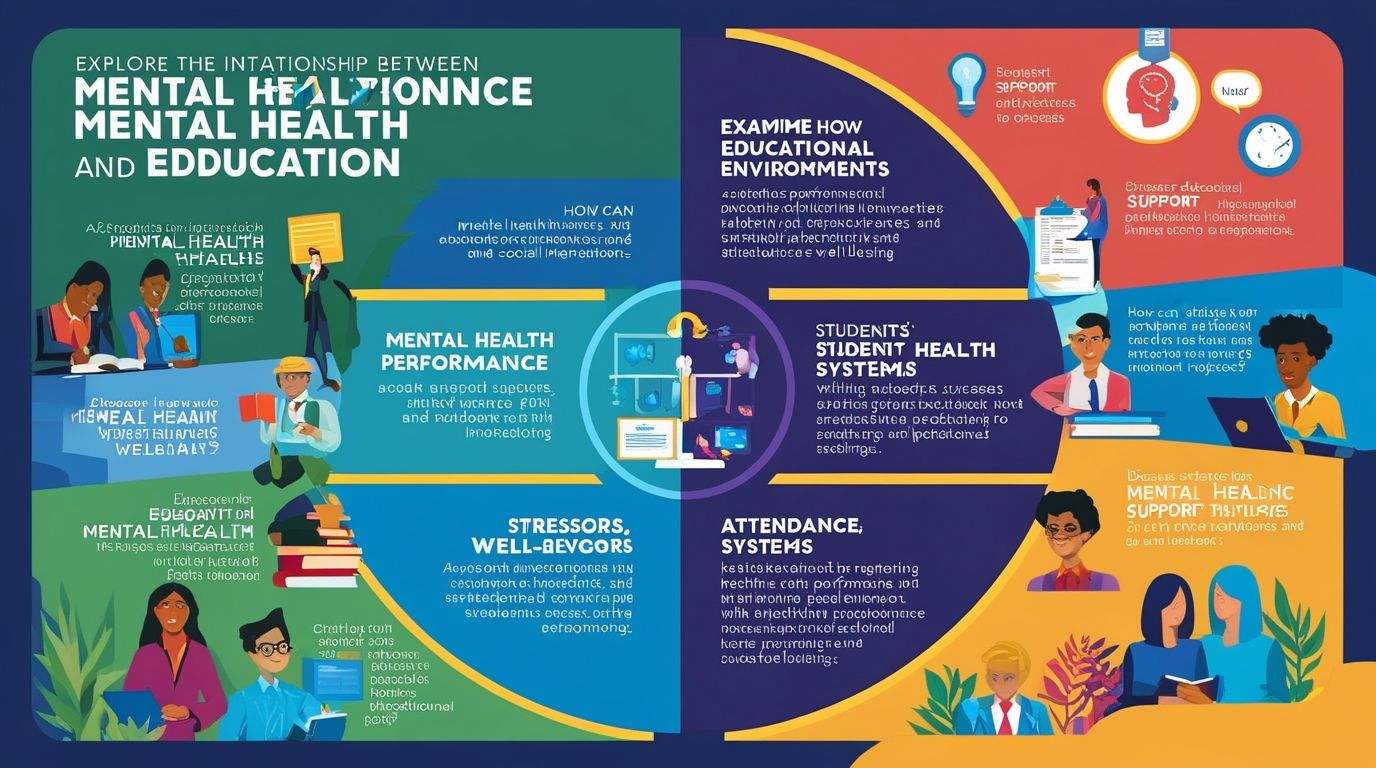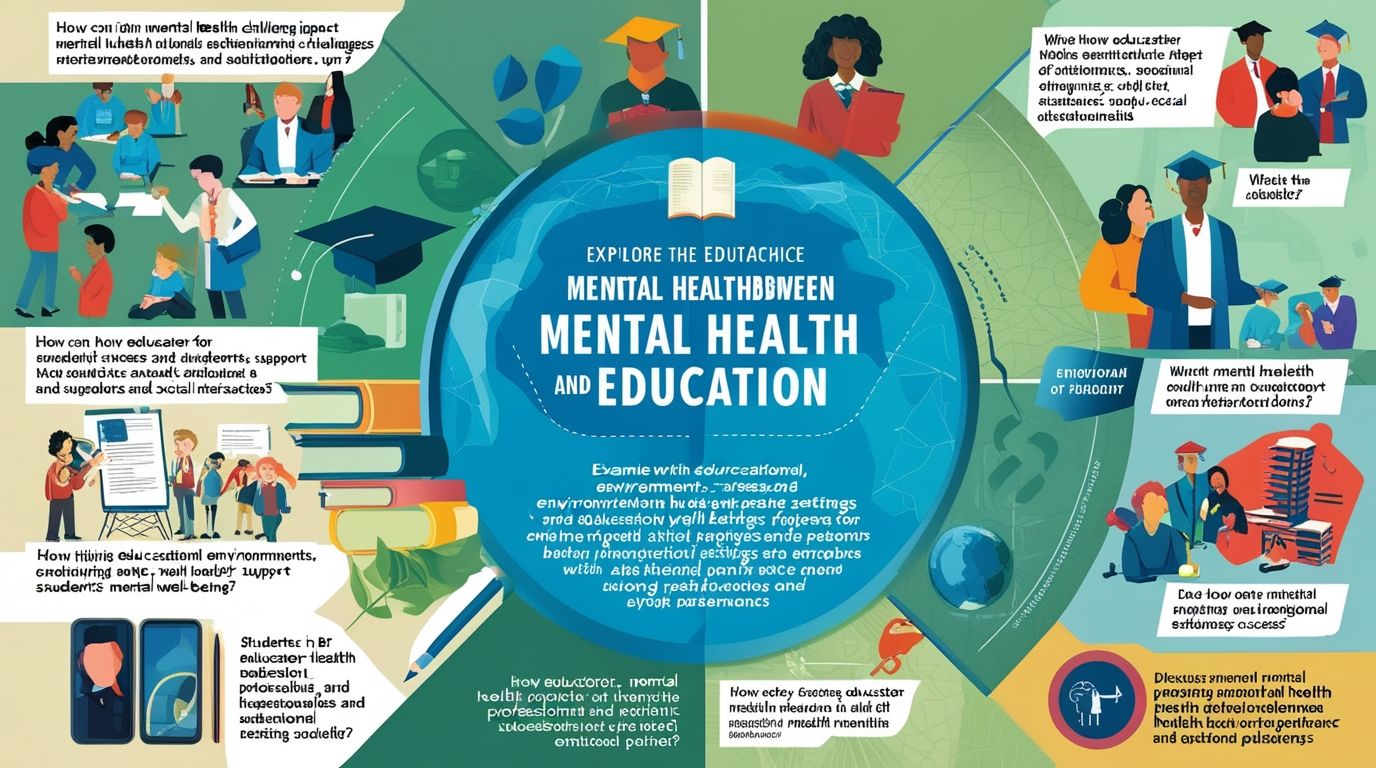Introduction
The Interplay of Mental Health and Education Mental health and education are deeply intertwined, with each significantly influencing the other. The impact of mental health on educational outcomes is well-documented, but the reverse—how educational environments affect mental well-being—is equally critical. This article explores these dynamics, examining how mental health impacts educational attainment and vice versa, and offers insights into creating supportive educational environments that foster both academic success and mental wellness.
The Impact of Mental Health on Education
1. Academic Performance and Cognitive Function
Mental health plays a crucial role in a student’s cognitive functioning, which directly affects their academic performance. Conditions such as anxiety and depression can impair concentration, memory, and decision-making abilities. For instance, students experiencing high levels of anxiety may find it difficult to focus during lessons or exams, leading to poor academic performance. Depression can also lead to diminished motivation and energy levels, further hindering a student’s ability to engage with their studies effectively.
2. Attendance and Engagement
Mental health issues can significantly affect school attendance and engagement. Students struggling with mental health challenges might experience a heightened sense of fatigue, social withdrawal, or fear, making regular school attendance challenging. Persistent absences can lead to gaps in learning, which can compound over time and lead to further academic struggles.
3. Social Interactions and Behavior
Mental health difficulties often affect how students interact with their peers and teachers. Issues like social anxiety or mood disorders can lead to problematic behavior or social isolation. For example, a student with social anxiety might avoid group activities or extracurriculars, missing out on valuable social learning and development opportunities. Similarly, behavioral problems arising from untreated mental health issues can create conflicts in the classroom, further impacting both the affected student and their peers.

The Impact of Education on Mental Health
1. Stress and Academic Pressure
Educational settings can be significant sources of stress. High academic expectations, standardized testing, and competitive environments can contribute to elevated stress levels among students. Chronic stress can lead to various mental health issues, including anxiety, depression, and burnout. The pressure to perform academically often exacerbates these conditions, creating a vicious cycle of stress and mental health struggles.
2. Support Systems and Resources
On a positive note, educational institutions have the potential to provide essential support systems and resources that can benefit students’ mental health. Access to school counselors, mental health programs, and supportive teacher-student relationships can play a crucial role in mitigating mental health issues and promoting overall well-being. Schools that integrate mental health education into their curriculum can also help normalize conversations about mental health, reducing stigma and encouraging students to seek help.
3. School Environment and Climate
The overall environment and climate of a school can significantly impact students’ mental health. Schools that promote inclusivity, respect, and a positive social atmosphere create a supportive environment conducive to mental well-being. Conversely, environments characterized by bullying, discrimination, or lack of support can adversely affect students’ mental health and academic performance.
Strategies for Integrating Mental Health and Education
1. Early Intervention and Prevention
Implementing early intervention strategies can prevent mental health issues from escalating and affecting academic performance. Schools can adopt screening tools to identify students at risk and provide timely support. Programs focused on emotional intelligence, stress management, and coping strategies can equip students with tools to handle mental health challenges proactively.
2. Professional Development for Educators
Educators play a pivotal role in recognizing and addressing mental health issues. Professional development programs can help teachers and school staff identify signs of mental health issues and understand how to provide appropriate support. Training in mental health awareness and crisis intervention equips educators to better support students and foster a positive learning environment.
3. Collaborative Approaches
Collaboration between mental health professionals, educators, and families is essential for creating a comprehensive support system for students. Schools should establish partnerships with mental health agencies and community organizations to provide additional resources and support. Regular communication between educators and families can also ensure that students receive consistent support both at school and home.
4. Creating a Supportive School Culture
Developing a school culture that prioritizes mental health involves fostering an environment where students feel valued, understood, and supported. Schools can implement programs that promote social-emotional learning, resilience building, and peer support networks. Encouraging open discussions about mental health and integrating mental health education into the curriculum can help normalize these conversations and create a more inclusive atmosphere.
5. Policy and Advocacy
Advocating for policies that support mental health in educational settings is crucial for systemic change. Policymakers should work towards integrating mental health services into school systems, ensuring adequate funding for mental health programs, and promoting policies that address the mental health needs of students. By prioritizing mental health in educational policy, we can create a more equitable and supportive educational environment for all students.
Conclusion
The relationship between mental health and education is complex and bidirectional. Mental health issues can significantly impact educational outcomes, while the educational environment can profoundly affect students’ mental well-being. By adopting strategies that prioritize mental health, integrating support systems into educational settings, and fostering a positive and inclusive school culture, we can create environments that support both academic success and mental wellness. As we move forward, it is essential for educators, mental health professionals, and policymakers to work collaboratively to address these challenges and promote a holistic approach to education that values the mental health of every student.

10 thoughts on “The Interplay of Mental Health and Education”
Comments are closed.